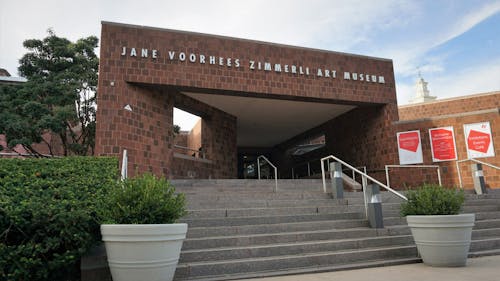Zimmerli pays tribute to Brodsky Center, Rutgers-founded printmaking studio

On September 13, the Zimmerli Art Museum debuted "The Brodsky Center at Rutgers University: Three Decades, 1986-2017," an exhibition on the longstanding print and papermaking studio under the direction of Judith K. Brodsky, according to the museum website.
Ferris Olin, a distinguished professor emerita at Rutgers and the exhibition's organizer, said that Maura Reilly, the director of the Zimmerli Art Museum, had wanted to pay tribute to the Brodsky Center, which moved from Rutgers to the Pennsylvania Academy of the Fine Arts in 2018.
For 30 years, the Brodsky Center aimed to provide state-of-the-art print and papermaking resources to artists around the world, particularly women, Black, Indigenous and gender non-conforming artists, Olin said.
"Visiting artists came in. They may not have had an idea about what they wanted to do, or they had something in mind. And then they worked with their collaborating print and papermakers to bring it to fruition," she said of the Center.
The Center welcomed those who were inexperienced with printmaking as well, according to Olin. Many would go on to become printmakers themselves, like James Lavadour, who eventually started the Crow's Shadow Institute of the Arts in Oregon.
"This was not a center that was only for professional artists. It was for the students who were emerging, who worked with those visiting artists and the master paper and printmakers," Olin said.
She said the Center's impact extended overseas, referencing a trip papermakers from the Center made to Ecuador. On this visit, the artists found plants that could be used to make paper, and their collaboration led communities in Ecuador to make books and other paper-based products to sell to tourists, enabling economic activity, Olin said.
The Brodsky Center embodied the "Jersey Roots, Global Reach" slogan that the University typically uses for programs involving studying abroad, she said.
The Center is currently named after Judith Brodsky, a distinguished professor emerita in the Department of Visual Arts at the Mason Gross School of the Arts, who founded it as the Rutgers Center for Innovative Print and Paper in 1986.
Due to the heteronormative nature of the art world in the 1980s, Brodsky said she wanted to combine her prior experience as an administrator at Rutgers—Newark with her passion for art and activism to create a space focused on women artists and artists of color.
"Prints are produced in editions, which means that there's more than one of the same thing, and so that means it can be spread around the world … So it's basically an arts discipline that can be used to promote democracy," she said.
Brodsky said that over time, she worked with artists who have gained fame and notoriety, and they have continued supporting the Brodsky Center in the present day.
Examples of such artists include Jaune Quick-to-See Smith whose work, "What is an American?" is displayed at the entrance to the Center's exhibition at the Zimmerli.
Olin said she and her team organized the Zimmerli's installation by theme and wanted each work to stand alone without any accompanying text.
"I made the curatorial decision not to have wall text for each image, each artwork because when I went to museums and galleries, I would watch people read the wall texts and then sort of glance at the work and then walk away," she said.
The works still have bilingual English-Spanish labels, but to learn more information from the artists directly, visitors must scan the QR code underneath each piece so as not to take away from the artwork in front of them, Olin said. In addition to the vast array of prints, there is also a video installation by Pepón Osorio present at the exhibit, she said.
Four hundred people attended the Zimmerli installation's opening reception, according to Brodsky. She said visitors repeatedly told Brodsky and Olin that they were overwhelmed by the unexpected emotional and intellectual impact the prints had on them.
"The art is about issues that affect people. It's not about concepts that are removed or that are for an elite few," Brodsky said.



